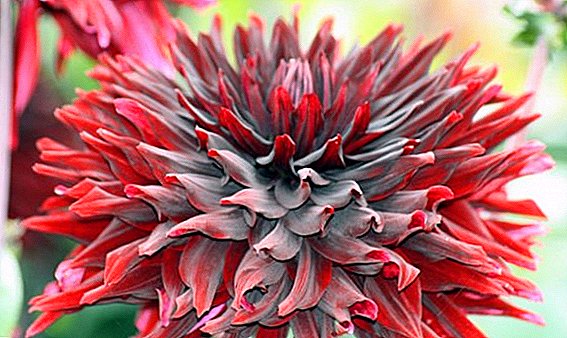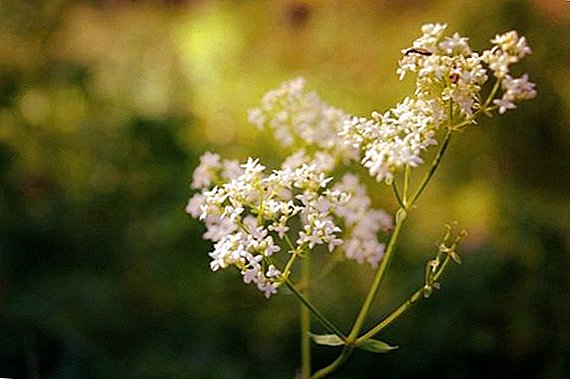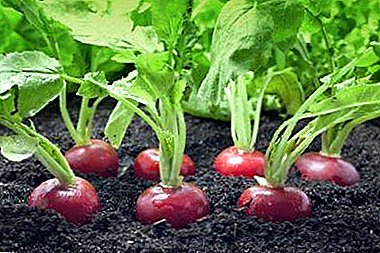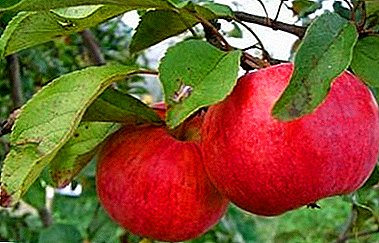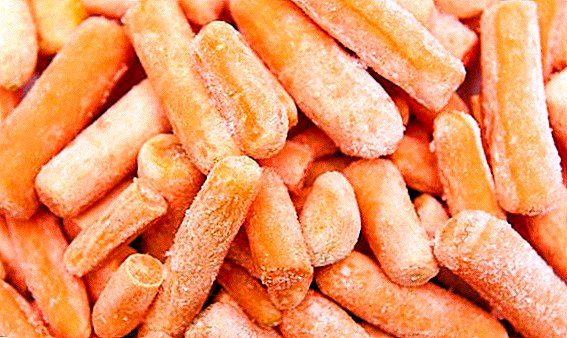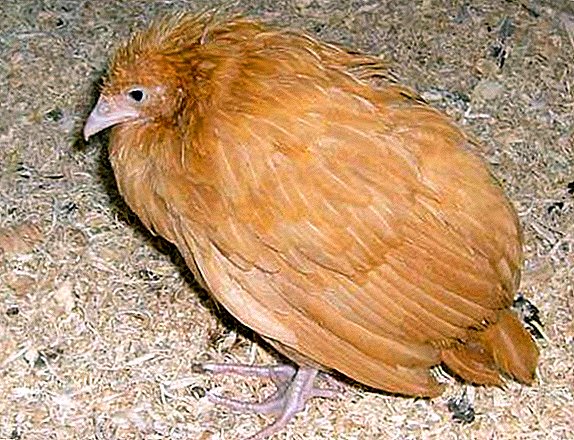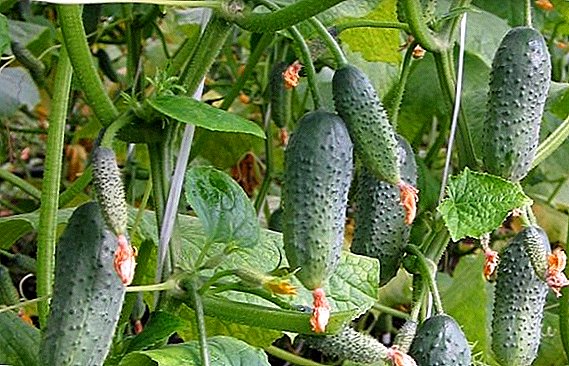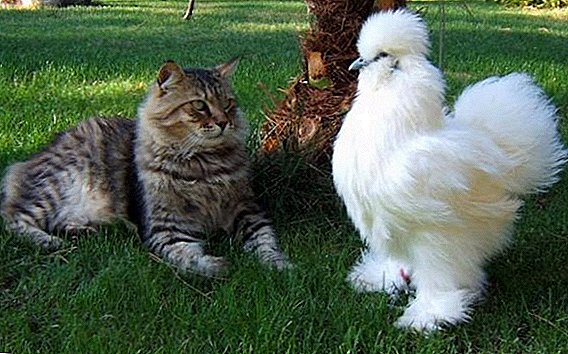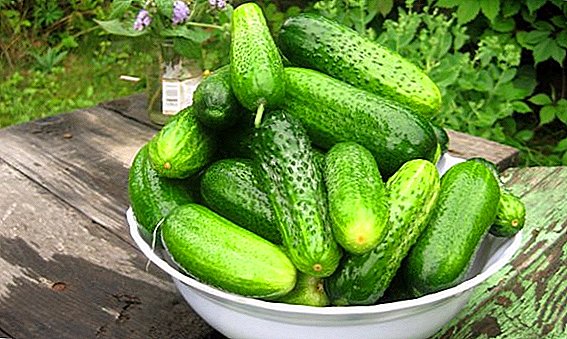 If you are in search of a fruitful and unpretentious variety of cucumbers for your backyard, then we advise you to pay attention to the "Moscow Nights" hybrid. It is popular among gardeners and, in general, has positive reviews.
If you are in search of a fruitful and unpretentious variety of cucumbers for your backyard, then we advise you to pay attention to the "Moscow Nights" hybrid. It is popular among gardeners and, in general, has positive reviews.
Variety description
"Moscow Nights" is a fairly young hybrid, bred and registered in 2000. Recommended for cultivation in all Russian regions.
The fruits of this hybrid ripen in average terms - from the emergence of seedlings to the formation of greenhouses takes 42-45 days.
Familiarize yourself with the methods of growing cucumbers in greenhouses, greenhouses, open ground.
Bushes at the plant weave heavily, have an average number of branches and one main stem. The leaves are medium in size, dark green, speckled with wrinkles. In one sinus formed from 1 to 3 ovaries.

The hybrid can be grown both in open ground and in greenhouses and greenhouses, however, the second option is preferable.
Did you know? The first greenhouses began to equip the ancient Romans. These were the simplest warmed constructions or mobile beds built in carts. Greenhouses appeared later - in the XIII century in Italy. Initially, they grew ornamental and medicinal plants. And only from the XIX century they began to be used for growing vegetables.Advantages of the "Moscow Evenings" hybrid:
- high yield;
- good adaptability to various growing conditions, including growing in the shade, which distinguishes the hybrid from its other relatives;
- excellent taste of Zelentsov;
- the universality of the fruit;
- the duration of the period of fruiting;
- high resistance to a number of diseases, including olive blotch, mosaic, powdery mildew;
- no need for pollination, as parthenocarpic hybrid.

Fruit characteristics and yield
Fruits form in the shape of an oval cylinder. On the skin there are rare large tubercles. The average weight of a green vegetable reaches 80-110 g, length - 12-14 cm. The skin color is dark green. It contains white stripes and spikes.
The pulp of cucumbers is not very juicy, it has no voids. Fruits are great for making fresh salads and for winter harvesting.
The yield of the "Moscow Evenings" hybrid reaches 15-17 kg per square meter. m. Somewhat inferior, but still good yields, achieved in growing conditions in partial shade.
Learn about the characteristics of cucumbers "Mammies favorite", "Chinese farmers", "Chinese disease-resistant", "Altai", "Far East 27", "Alligator", "Chinese miracle", "Buyan", "Claudia", "Murashka", " Beam Splendor, Green Stream.
Selection of seedlings
If you do not have the possibility of self-growing seedlings, then you need to know by what criteria it should be chosen. The best for planting are sprouts at the age of one month. Therefore, before buying you need to ask the seller when the seedlings were planted.
The second thing you should pay attention to is the condition and size of the stem. It should be strong, reaching a length of 25-30 cm.

Sprouts should have a healthy crown type, well developed, it should emanate a pleasant fresh scent.
The knee must be 5 cm long.
Be sure to look under the sheets and inspect the stem - the presence of malicious insects you will see with the naked eye. If there are any spots, black spots on the leaves or stem, then such plants do not need to buy.
It is also not necessary to take sprouts with light leaves or a thin stem. From such a seedling healthy quality cucumbers do not grow.
Find out what varieties of cucumbers should be grown in the open field.
Soil and fertilizer
The best cucumbers grow in fertile loamy or sandy soil with a neutral or slightly elevated pH.
They can be planted in the ground, where they previously grew potatoes, onions, tomatoes, cabbage. And it is not recommended to plant after cucumbers, watermelons, melons, zucchini, pumpkins, squash.
Before planting, both in open ground and in protected soil, it will be necessary to fertilize the soil first. Methods of preparation are somewhat different.

In protected ground. In the greenhouse or greenhouse, soil preparation begins in the spring. The top layer of soil is removed and covered with a layer of manure 30-40 cm in height. Small holes are made throughout the layer, into which hot water is poured. Overheating of manure will occur over several days. All this time, the bed will be warm.
Before planting the seedlings, a layer of 2 parts of sod land, 2 parts of humus, 1 part of sand or sawdust is placed on top of the manure layer. To remove harmful microorganisms from the soil, it is watered with a solution of potassium permanganate.
Learn how to apply organic fertilizers - chicken dung, pork, rabbit, sheep manure, peat, dolomitic, bone, fish meal, nettle extract.
In the open ground. In the garden also equipped with multi-layer warm beds, which are prepared in the fall. First put a drainage layer of straw, grass, branches 30-50 cm tall. Then put fresh manure. In the spring, another layer is filled up - from the soil enriched with vitamins and minerals. On the prepared bed, arcs are set and a film or other special material is placed on them that will allow it to warm up.
If it has not been possible to prepare the beds since the autumn, then in the spring one layer of manure or compost is placed with the addition of 3 cups of wood ash and nitrophoska at the rate of 100 g per 1 square meter. m. It is placed on fertile land. This bed is also covered with a film, but without using arcs, but simply pressing it with heavy objects, such as bricks. In this state, the land should stand for at least 7 days. After this period, it will be ready for planting.

Growing conditions
Air temperature. For planting heat and light-loving cucumbers assign a plot, which is under the sun's rays and protected from drafts. The plant achieves the best growth at an air temperature of + 22-26 ° C. In the greenhouse, it is recommended to maintain conditions at + 18-20 ° C. The plant does not tolerate temperatures below +14 ° C and above +42 ° C - it stops growing and developing. Cucumbers also do not tolerate temperature fluctuations.
Soil temperature. The land in which plants grow should not be colder than +16 ° C. They feel most comfortable at + 20-24 ° C.
Cucumbers have become so popular product that people are accustomed to grow them in unusual ways - in a barrel, in bags, in buckets, in hydroponics, on a windowsill, on a balcony, in plastic bottles.Shine. For the normal development of cucumbers, they need a light day lasting 10-12 hours. Poor plant health is affected by both shorter and longer daylight hours. So, increasing it to 16 hours and more will delay the time of fruit.
Soil moisture. Cucumbers are sensitive to both soil moisture and air. The earth should be moistened to the state of 65-75%, in the period of the appearance of fruits - up to 80%.
Air humidity. The air must also be very humid - 85-90%. If it is overcast outside, it is possible to reduce the humidity to 70-80%. Increasing it to the level of 95% and higher is fraught with the development of the disease ascochytosis, with a decrease to 60% - withering.

Growing from seed to seedlings at home
Cucumbers can be planted with dry seeds in the ground, pre-germinated seeds and seedlings.
In the middle lane and northern regions, cucumbers should be planted only with the help of seedlings. So it will be possible to get fruits earlier and to achieve more long-term fruiting.
For growing seedlings need to prepare in advance the seeds, soil and capacity.
Learn how to prepare soil for seedlings, how to use cassettes, peat tablets, how to carry out preplant treatment of cucumber seeds.
Seed preparation
To correctly calculate the time of planting seeds for seedlings, you should count from the time of planting in the greenhouse or garden for 20-30 days. The landing time for each region will be different. You can also use the recommendations of the lunar calendar.
Purchased and packed seeds in a specialized market do not need to be processed. Those bought on the market should be disinfected in a solution of potassium permanganate or in the Epin preparation.

Content and location
Seeds for seedlings are planted immediately in peat pots or plastic cups. The fact is that the shoots do not tolerate a pick.
The soil for growing seedlings can be purchased or mixed from turf land, peat, sand and drainage.
The temperature for growing seedlings should be maintained at + 20-22 ° C during the day and +18 ° C at night. Lowering the thermometer below +12 ° C is unacceptable.
The optimal duration of daylight hours is 10-12 hours. If the seedlings will be grown on the windowsill, then it will need to shade from the sun.
Learn how to choose a seedling lamp.
Seed planting process
Seeds are planted only in moist and warm soil. A hole 2 cm deep is made in the ground. 1-2 seeds are put into each hole. The pits are covered with soil substrate.
Immediately after landing, the tanks are placed in a room where the temperature is kept at + 22-28 ° C. Under such conditions, sprouts should appear in 2-3 days.
Video: an interesting way to plant cucumbers
Care of seedlings
Care of seedlings is not difficult - will require watering, fertilizing and hardening. For irrigation use warm water. Seedlings watered in the morning, do it every other day.
Top dressing is produced in the phase of two true leaves. Stimul-1 complex fertilizer or an aqueous solution of mullein (1: 1) is excellent for this purpose.
You can also fertilize plants with 20 g of superphosphate, combined with 10 g of ammonium nitrate, 15 g of potassium chloride and diluted with 10 liters of water. There will be two such feedings. The first is recommended to be done a week after the shoots are formed, the second - 7 days after the first.
7 days before you plan to plant seedlings in the ground or greenhouse, you need to start the process of hardening. First, the pots with sprouts carried out on the street for 5 minutes. Every day the length of stay in the open air is increased.
A day before the proposed day of landing on a permanent place, the soil in the pots is well watered.

Important! Do not allow seedlings to bloom. If this happens, then you will need to get rid of flower stalks.The seedlings ready for movement into the ground should have strong stems 30 cm long, 3-5 true leaves and a well-developed root system.
Transplanting seedlings to ground
The recommended dates for sowing seeds or planting seedlings in the middle lane in the greenhouse are from May 15 to 20, and in the garden from June 1 to 5. In the northern regions of the open ground cucumbers planted in early June. It is at this time that conditions are usually established that are suitable for the cultivation of vegetables — soil temperature is + 16-18 ° C, air temperature is + 18-20 ° C.
Learn more about how to plant cucumber seedlings in the greenhouse.
In order to avoid the development of diseases or other problems in the development of plants in the future, one should adhere to the recommended planting density - no more than 4 plants per 1 square meter. m open ground and 2.5 plants per 1 square. m protected ground.
Landing scheme - 30x150 cm.

Seedlings in peat pots are placed in the holes (they must fit there completely) and pour 3 liters of water on each bush.
Plants are extracted from plastic cups together with an earthy clod and, without destroying it, they are planted in holes.
At first, sprouts must be protected from sunlight. It will be necessary to water every day or every other day with necessarily warm water. If temperatures are expected to drop to +15 ° C, the beds should be covered with foil on the arcs.
It is interesting to know whether to pick off the leaves of cucumbers.
Agrotechnics growing seeds in open ground
The greatest yield of cucumbers can be achieved only by cultivating them from seedlings. However, since “Moscow evenings” are distinguished by strong immunity and the ability to take root well in almost any conditions, they can also be grown by sowing seeds in unprotected soil.

Outdoor conditions
Cucumbers, grown immediately from seeds, require that the ground at a depth of 12 cm warmed to +15 ° C. The plot is pre-heated under the film. It is better to plant a hybrid "Moscow evenings" on a plot that is open to sunlight and closed to drafts. However, this cucumber can also be planted in light shade.
After sowing the seeds for the first couple of weeks, you should cover the beds with film on the arcs.
For a good harvest, it is important to know when to plant cucumbers in open ground, how to water cucumbers in open ground.
The process of planting seeds in the ground
Before planting the seeds they are disinfected in an aqueous solution of potassium permanganate and boric acid (1 g / 0.2 g / 10 l) for 15 minutes. After disinfection, they are soaked for pecking - planting material is wrapped in wet gauze and kept at a temperature of + 20-25 ° C. After they hatch, they are quenched by placing in a refrigerator.
In the open ground, the seeds of the hybrid "Moscow Evenings" should be planted in April and May. The embedding depth is 2-3 cm. 2-3 seeds are placed in each well.
Shoots should appear after 3-4 days. When they form the first true leaflets, they are thinned out, leaving stronger specimens.

Watering
Care of seedlings will be in regular irrigation, combined with dressings, weeding and loosening the soil.
Important! Cucumbers are watered only with warm water heated to a temperature not lower than +23. WITH.Humidification is better to produce after dinner, when the air and the soil warms up under the sunlight.
On 1 square. m planting young cucumbers will need 5-10 liters of water. Watering is temporarily suspended during flowering and resumed when the plant begins to set fruit. In the fruiting phase, water volumes should be increased to 15-20 liters per 1 square meter. m
During the dry season, watering should be more frequent and abundant. In rainy weather, their multiplicity and volume should be reduced.
Soil loosening and weeding
In order for the soil to gain better breathability and better air flow to the root system, it is important to regularly loosen. This must be done after irrigation, precipitation, in case of formation of a crust. To loosen should be very careful, not penetrating into the soil deeper than 4 cm, otherwise you can damage the roots.

Weed removal with weed is carried out when necessary. It is important not to allow the site to become very clogged, otherwise it will hurt the development and yield of cucumbers.
Find out why cucumber leaves turn white, turn yellow and dry, wither, why blackflies appear on them.
Masking
Masking is not a compulsory cucumber care procedure. This event allows to reduce the load on the plant and, accordingly, increase the number of fruits, as well as speed up the process of their ripening.
Pasony is the removal of lateral shoots. It is produced when the plant has already formed 5-7 leaves. In hybrids, as a rule, 2-3 stems with ovaries are left, pinching them over the second leaf. All side shoots are removed. They also get rid of the ovaries and shoots in the axils of the first 4 leaves from the ground. Leaves do not touch.

Next time pasynkovanie produce when there will be 9 leaves, then - with 11 leaves. In the future, all stepchildren are removed.
Important! The extra 30-50 cm of shoot can reduce the yield of the bush by 1-1.5 kg.
Garter
It is advisable to tie cucumbers so that the fruits do not touch the soil and it is convenient to pick them up. Gardeners have come up with many methods how to do this. For example, in the horizontal method, metal pillars or wooden beams are used, on which several times with intervals of 25-30 cm they stretch the rope. On the bottom rope cling lash.
The vertical method involves the installation of supports at the edges of the beds and stretching one rope on them from above. Then on a rope tied cloth strips 2-3 cm wide. To each strip attach lash one cucumber bush.
Tying is also carried out using a special mesh, trellis.

Top dressing
Top dressing should be made three times. They need to be combined with soil moistening. For the first time, fertilizers are applied at the moment when the first leaves of the sprouts are formed. Bring organic - water solution of mullein. The second time the soil is fertilized in 2-3 weeks, the third - before the whips begin to close.
Under cucumbers, besides organic matter, you can also make a prepared mixture of ammonium nitrate, potassium salt, superphosphate (all substances 10 g each), diluted in a bucket of water.
If there is a need, then foliar fertilizers can be applied - in a bucket of water, 12 g of superphosphate, 7 g of potassium chloride, 5 g of urea are diluted. On 1 square. m use half a liter of the prepared solution.
Learn more about cucumber feeding.
Pests, diseases and prevention
The "Moscow Evenings" hybrid is immune to olive spot, mosaic, powdery mildew and has moderate resistance to downy powdery mildew. However, he has no immunity against other diseases. Cucumber can also suffer from the invasion of harmful insects.

In the fight against diseases and pests in the first place are preventive measures.Before planting, the ground should be shed "Fitosporin". This will protect the culture from Fusarium. This drug is also suitable for the treatment of gray rot. White rot is fought with the help of Topaz, with the root rot - copper sulfate. It is important to prevent plant thickening, stagnation on the bed of moisture, exposure to low-temperature bushes, weed infestation of the site.
Among the insects in cucumbers, there are many enemies, with each of which allows you to fight a certain insecticide:
- with a sprout fly - "Iskra";
- with the whitefly - "Aktara", "Konfidor", "Aktellik", "Inta-vir";
- with spider mite - "Fitoverm";
- with aphids - "Decis", "Inta-vir";
- with thrips - "Aktara", "Fufanon", "Golden Spark";
- with nematode - "Marshal".
If the weather failed and cucumbers got sick, find out how to deal with cucumber diseases.
Harvesting and storage
During the fruiting period, it will be necessary to have it twice a day every day (when there is a mass emergence of fruits), and then after 1-2 days it will be necessary to bypass the beds and gather ripe fruits.

When harvesting cucumbers with lashes curled. It is important not to pull and not to pull the shoots, so as not to damage them. Gather not only mature Zelentsy, but also damaged, malformed. Otherwise they will weaken the plant.
You can store cucumbers for a week, a maximum of two, in the refrigerator. For preservation for a longer period use the method of canning. Cucumbers can also be frozen.
Cucumber "Moscow evenings" is good fresh, so it is useful to know how to save cucumbers.
Possible problems and recommendations
Like any other plant, cucumbers react with changes in appearance, when their development occurs incorrectly and mistakes are made in the care. We have compiled a list of the most frequent problems that arise when growing cucumbers, and ways to solve them:
- Lower leaves turn yellow, and fruits form irregularly shaped and light-skinned - a sign of a lack of nitrogen. Solution - feeding 2 tbsp. l urea diluted in a 10-liter bucket of water. Liquid consumption - half a liter per plant.
- A yellow edging appeared on the leaves; the green leaves are formed in the shape of a pear - a sign of potassium deficiency. Solution: feeding with 1 glass of wood ash, diluted in a 10-liter bucket of water. Solution consumption - 3 liters per 1 square. m
- Leaves curl, flowers fall, the ovary does not form, sluggish fruit is a sign of a lack of calcium. Solution - feeding from 3 tbsp. l calcium nitrate, diluted in a 10-liter bucket of water. Solution consumption - 0.5 l per 1 bush.
Did you know? Cucumbers have healing properties that have been known for a long time. So, they are mentioned in the medical book "Cool Helicopter", dated XVII century. Folk healers recommended drinking a decoction of cucumbers to quench their thirst, replacing them with water, and also use them as urine, gall, and carminatives.

In conclusion, we emphasize that the hybrid "Moscow Nights" since its launch is constantly included in the list of the best cucumbers for growing in the middle lane. It is good to cultivate in home gardens and small farms. To grow a hybrid under the force and an experienced gardener, and a beginner. It is suitable for growing in light shade, adapts well to any conditions, brings consistently high yields of tasty fruits, has strong immunity against major cucumber diseases.
Reviews about "Moscow evenings"




